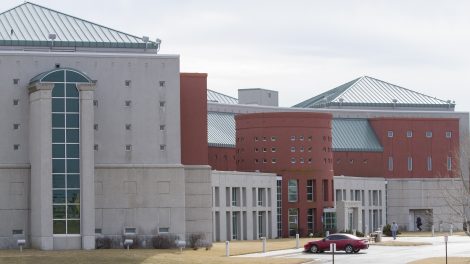Study indicates no need to expand Douglas County Jail, Justice Matters argues

photo by: Mike Yoder/Journal-World File Photo
The Douglas County Jail is shown in this file photo from February 2015.
An activist group opposed to the expansion of the Douglas County Jail now has a study that supports the idea that the county should invest in long-term alternatives to incarceration programs rather than building more jail cells.
“All you’re doing is putting a Band-Aid on a problem that you can solve in so many other ways and make for better outcomes,” Danielle Rudes, the lead researcher for the study, said about the county’s plan to expand the jail.
Douglas County officials who are pushing for a $29.6 million expansion of the jail didn’t immediately refute the study — which was commissioned by faith-based group Justice Matters — but likely will. Instead, Karrey Britt, a spokeswoman for the county, said in an email that Justice Matters did not share the report with the county, despite holding a press conference Wednesday to release its findings.
Britt further said the county believed that researchers who compiled the report “did not reach out to anyone who currently works in the Douglas County criminal justice system” about the results of the study.
Rudes, an associate professor of criminology, law and society at George Mason University, said the study compiled the inmate population and the criminal-justice and related programming in Douglas County and its surrounding area. The study then compared those with national data to find whether the programs in the area are effective and point out where the county can provide additional services to be more effective.
Rudes said the study showed that programming offered through the Douglas County Jail did not provide effective rehabilitation of inmates. That’s not unusual, she said, because safety and security — not rehabilitation — of the people housed there is a jail’s main focus.
“We want to see people go into custodial facilities and come out better than they were when they went in, which is not at all what we see in jails and prisons around the U.S.,” Rudes said. “(Jails are) caught in a weird mix of control and punishment and rehabilitation, and those things don’t go well together,” she later added.
However, programs based in a community setting have been more effective at addressing issues such as recidivism, Rudes said.
Douglas County in recent years has launched several alternative programs to incarceration — including pretrial release, house arrest and the behavioral health and drug courts — that have led to a decrease in jail population, but county officials said those programs did not completely solve the issue.
Rudes said the county’s alternative programming is working and could be enough in the long term to decrease the inmate population. She noted that includes the use of the planned Douglas County behavioral health crisis center, which is slated to begin operating in late 2021.
“When the new behavioral health campus opens in Douglas County (with) a strong diversion program, of which Douglas County already established, a good percentage of those arrested with mental health diagnoses or flags may be diverted to services outside the jail,” the researchers wrote in the study. “This frees up bed space (in the jail).”
Shannon Portillo, a researcher for the study and associate professor for the University of Kansas’ School of Public Affairs and Administration, said that was the key point of the study.
“Part of what this study highlights is how we can invest in sustainable and long-term solutions for Douglas County, and that investment isn’t expansion of the jail,” Portillo said.
Ben MacConnell, a member of Justice Matters, told the Journal-World during the press conference that the group had not shared the study with the county yet but the group intended to send it to the county eventually.
Justice Matters previously told the Journal-World in January that it was pursuing two studies and it hoped the county would hold off on its plan to approve the jail expansion until it was finished. However, the County Commission approved the plan the following week.
MacConnell said the second study was still underway.
The studies are a part of a yearslong effort by Justice Matters and others to stop the county from expanding the jail to house more inmates. Two years ago, county voters rejected a half-cent sales tax that would have funded a $44 million jail expansion.
As the Journal-World has reported, county leaders say that the jail is overcrowded, making it unsafe for both staff and inmates; opponents argue that the county needs to try more alternatives to incarceration to lower the jail’s population.
Additionally, Justice Matters and another local nonprofit, Lawrence Sunset Alliance, along with five county residents, in a lawsuit are petitioning for an injunction to stop the county from issuing bonds to fund the planned expansion, estimated to cost roughly $29.6 million, plus a separate estimated $1.5 million renovation of the jail’s central heating and cooling plant.
The county had approximately $9 million on hand to go toward the jail, the Journal-World has reported. County staff planned to pursue a bond issue with a 20-year debt service to finance the rest of the estimated $31.1 million total, which is about $22.1 million.
The county said it expected the expansion to increase the jail’s operating cost by $6 million, which would be subsidized by $2.4 million worth of budget cuts the county made in 2019 and by saving about $1 million each year from no longer housing inmates out of the county. That would leave the county with a $2.6 million hole to fill through either making more cuts to the budget or raising local property taxes.
The jail currently has 186 beds for inmates, but the county wants to add up to another 112 beds.
However, during the coronavirus pandemic and state stay-at-home orders, the county jail’s inmate population has decreased significantly.
The jail’s population has fallen to 129 inmates, with another six inmates housed out of county and another two listed as temporarily out, according to statistics on the jail’s website Wednesday afternoon. Prior to the stay-at-home orders in March, the jail housed 176 inmates, with 25 housed out of county, according to the jail’s March 13 statistics.
Contact Dylan Lysen
Have a story idea, news or information to share? Contact reporter Dylan Lysen:
- • dlysen@ljworld.com
- • 785-832-6353
- • Twitter: @DylanLysen
- • Read other stories by Dylan







